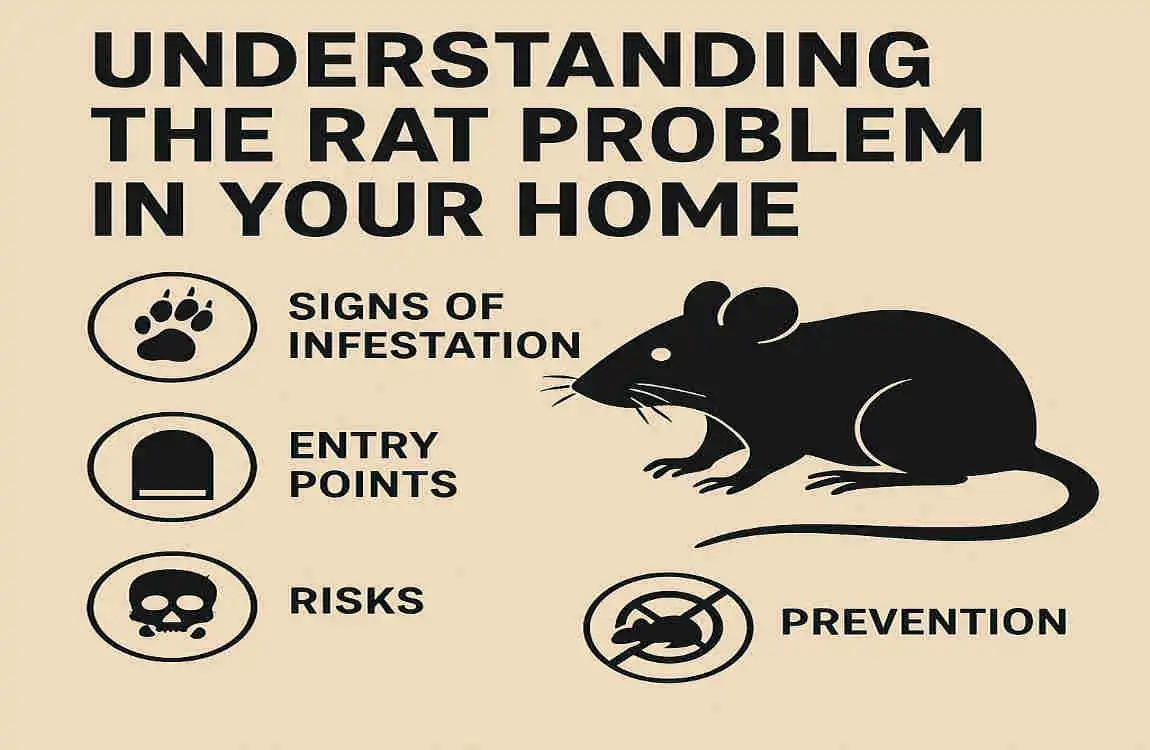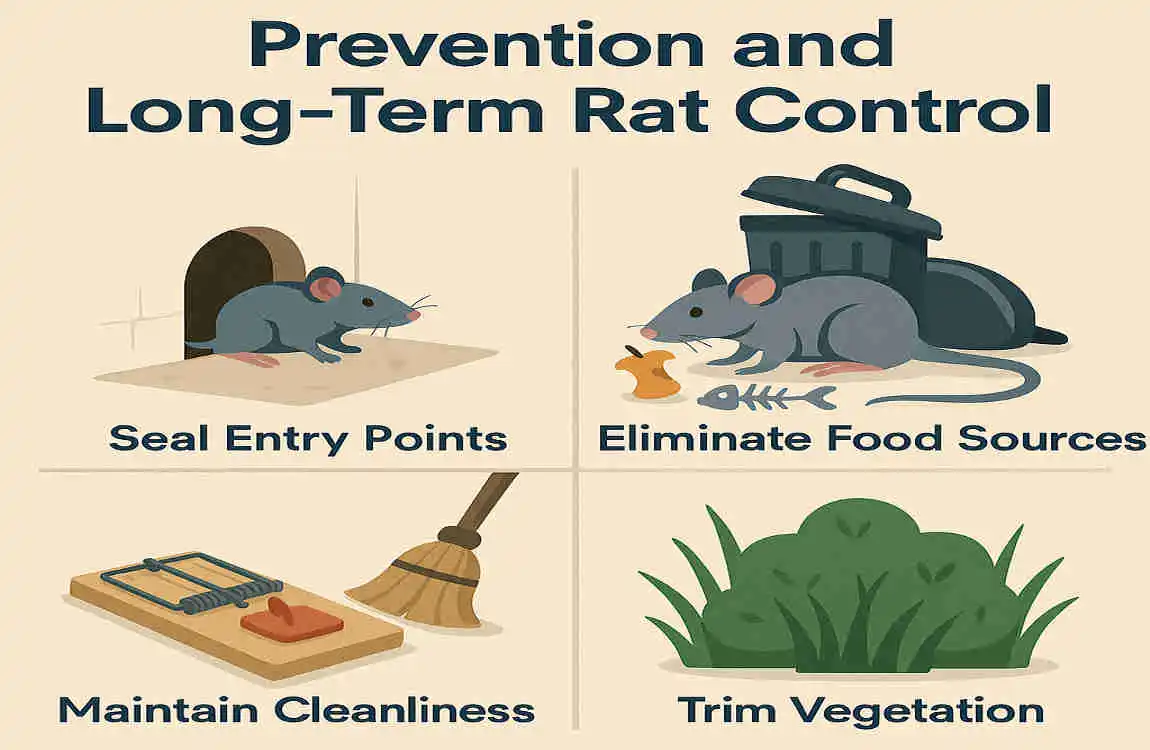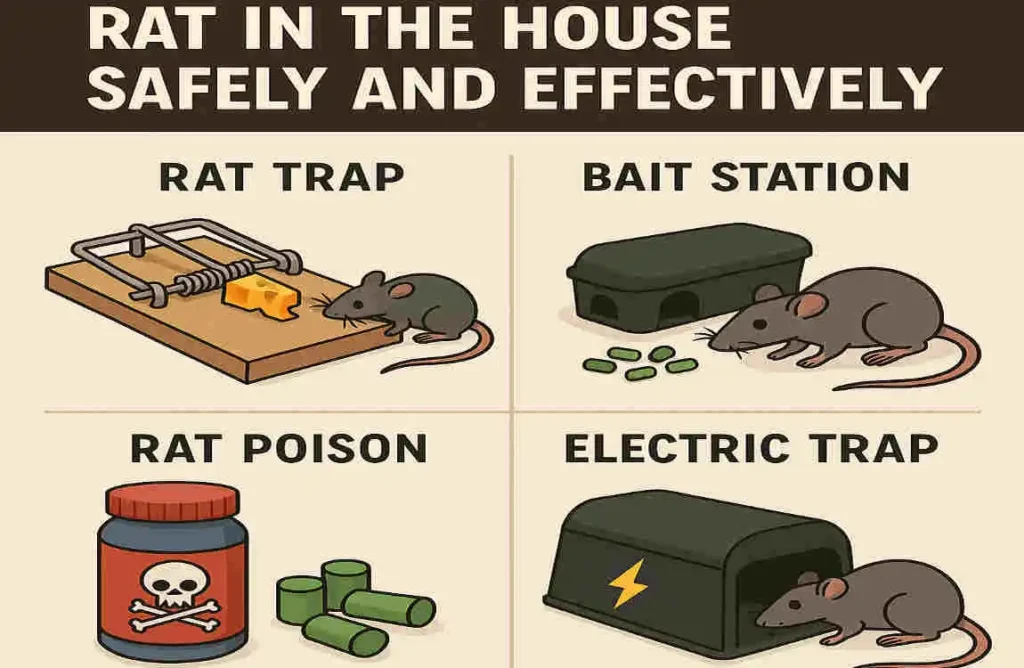Are you dealing with a rat problem in your home? If so, you’re not alone. Rats are a common household pest that can cause all sorts of issues, from property damage to health risks. But don’t worry, we’re here to help!
Understanding the Rat Problem in Your Home

Why Rats Invade Houses
Rats invade houses for three main reasons: food, shelter, and breeding. Your home provides all of these things, making it an attractive place for rats to set up shop. They’ll eat anything from crumbs on the floor to pet food in bowls, and they’ll nest in warm, secluded areas like attics and basements.
Common Signs of Rat Infestation
If you suspect you have a rat problem, keep an eye out for these common signs:
- Droppings: Rat droppings are small, dark, and pellet-shaped. You might find them in areas where rats are active, like kitchens and pantries.
- Gnaw marks: Rats have to chew constantly to keep their teeth from growing too long. Look for gnaw marks on wood, plastic, and even electrical wiring.
- Noises: Rats are most active at night, so listen for scratching, scurrying, or squeaking sounds coming from walls, ceilings, or floors.
Health Risks and Property Damage Caused by Rats
Rats can pose serious health risks to you and your family. They can carry diseases like leptospirosis, salmonellosis, and hantavirus, which can be transmitted through their droppings, urine, and saliva. Rats can also cause significant property damage by chewing through walls, insulation, and electrical wiring, which can lead to fires and other hazards.
Importance of Quick and Safe Removal
It’s crucial to address a rat problem quickly and safely. The longer you wait, the more damage rats can do to your home and the greater the risk of disease transmission. But it’s also essential to use safe and effective methods to get rid of rats, especially if you have children or pets in the home.
Assessing the Situation: When and Why You Should Act
When the Rat Problem Becomes Urgent
You should act immediately if:
- You see rats during the day, indicating a severe infestation.
- You find rat droppings in areas where you prepare or eat food.
- You hear rats in your walls or ceilings, which can indicate a large nest.
Why DIY vs Professional Extermination
Whether you choose to tackle the rat problem yourself or hire a professional depends on the severity of the infestation and your comfort level with handling pests. DIY methods can be adequate for small infestations, but if the problem is widespread or you’re not sure how to proceed, it’s best to call in a professional.
Safety Considerations Before Starting Any Control Method
Before you start any rat control method, make sure to:
- Wear gloves and a mask to protect yourself from disease.
- Keep children and pets away from areas where you’re setting traps or using poison.
- Read and follow all instructions carefully to avoid accidents.
The Best Way to Kill a Rat in the House: Safe Urgency
When it comes to killing rats in your home, the best approach is both safe and effective. You want to get rid of the rats quickly without putting yourself, your family, or your pets at risk. In the next section, we’ll discuss the best methods for safely and effectively killing rats.
The Best Way to Kill a Rat in the House: Overview of Methods
When it comes to killing rats in your home, you have several options to choose from. Here’s a quick summary of the primary methods:
- Traps: Snap traps and electronic traps are both effective ways to kill rats quickly and safely.
- Poisons: Rodenticides can be effective, but they come with significant risks and should be used with extreme caution.
- Natural remedies: Natural repellents and humane traps can be used to deter rats or catch and release them, but they may not be as effective as other methods.
- Professional services: If the infestation is severe or you’re not comfortable handling the problem yourself, consider hiring a professional pest control company.
In the next section, we’ll dive into each of these methods in more detail, discussing their pros and cons and how to use them safely and effectively.
Safe and Effective Rat Killing Methods
Snap Traps: Classic and Efficient
Snap traps are a classic and efficient way to kill rats in your home. Here’s how they work and how to use them effectively:
How Snap Traps Work
Snap traps use a spring-loaded bar to quickly and humanely kill rats when they take the bait. When a rat touches the trigger, the bar snaps shut, breaking the rat’s neck and killing it instantly.
Best Placement Strategies
To increase your chances of catching a rat with a snap trap, place them:
- Along walls and in corners, where rats tend to travel.
- Near signs of rat activity, like droppings or gnaw marks.
- In areas where you’ve seen rats or heard them scurrying around.
Types of Bait That Work
Rats are attracted to a variety of foods, but some of the most effective baits include:
- Peanut butter
- Bacon
- Cheese
- Nuts
- Dried fruit
Pros and Cons
Snap traps have several advantages:
- They’re safe and quick, killing rats instantly.
- They’re reusable, so you can keep using them until the infestation is gone.
- They’re relatively inexpensive and easy to find at most hardware stores.
However, there are a few drawbacks to consider:
- You have to handle dead rats when disposing of them.
- They may not be suitable for homes with small children or pets, as they can be a choking hazard.
Safety Tips for Families with Kids or Pets
If you have children or pets in your home cleaning, take extra precautions when using snap traps:
- Place traps in areas where children and pets can’t access them, like behind appliances or in locked cabinets.
- Use tamper-resistant bait stations to keep bait away from curious hands and paws.
- Check traps regularly and dispose of dead rats promptly to avoid attracting other pests.
Electronic Traps: Modern and Humane
Electronic traps are a modern and humane way to kill rats in your home. Here’s how they work and how to use them effectively:
How Electronic Traps Kill Rats Instantly
Electronic traps use a high-voltage shock to kill rats instantly upon entry. The shock is powerful enough to kill the rat quickly and humanely, without causing any suffering.
Advantages Over Traditional Traps
Electronic traps have several advantages over traditional snap traps:
- They’re more humane, killing rats instantly without causing pain or suffering.
- They’re safer for children and pets because they don’t have any exposed parts that could cause injury.
- They’re more effective, as rats can’t steal bait without triggering the trap.
How to Use and Maintain Electronic Traps
To use an electronic trap effectively:
- Place the trap in an area where you’ve seen rat activity.
- Bait the trap with a small amount of food, like peanut butter or bacon.
- Turn the trap on and leave it in place for several days or until you catch a rat.
- When you catch a rat, dispose of it in accordance with local regulations and clean the trap before reusing it.
To maintain your electronic trap:
- Check the batteries regularly and replace them as needed.
- Clean the trap after each use to remove any debris or odors that might deter rats.
- Store the trap in a cool, dry place when not in use to prolong its life.
Safety and Eco-Friendliness
Electronic traps are generally safe to use around children and pets when used as directed. They’re also more eco-friendly than traditional traps, as they don’t use any chemicals or poisons that can harm the environment.
Rat Poison: Use with Extreme Caution
Rat poison, or rodenticide, can be an effective way to kill rats, but it comes with significant risks and should be used with extreme caution. Here’s what you need to know:
Types of Rodenticides Available
There are several types of rodenticides available, including:
- Anticoagulants: These work by preventing blood from clotting, causing the rat to bleed internally and die.
- Bromethalin: This neurotoxin causes paralysis and death by disrupting the rat’s nervous system.
- Cholecalciferol: This vitamin D3 derivative causes hypercalcemia and kidney failure in rats.
How They Work and Kill Rats
Rodenticides work by attracting rats to eat the poison, which then kills them through various mechanisms depending on the type of poison used. The rat may die within a few days of ingesting the poison, depending on the type and amount consumed.
Risks Involved with Poison Use
Using rat poison comes with several risks:
- Pets and children: Rodenticides can be toxic to pets and children if ingested, so they must be used with extreme caution.
- Secondary poisoning: Predators that eat poisoned rats can also be affected by the poison.
- Environmental contamination: Improper disposal of rodenticides can lead to environmental contamination and harm to wildlife.
Safety Guidelines and Legal Considerations
To use rat poison safely and legally:
- Always read and follow the manufacturer’s instructions carefully.
- Keep rodenticides out of reach of children and pets.
- Use tamper-resistant bait stations to prevent accidental ingestion.
- Dispose of dead rats and unused poison according to local regulations.
Alternatives to Chemical Poison
If you’re concerned about the risks associated with rat poison, consider these alternatives:
- Snap traps: A safe and effective way to kill rats without chemicals.
- Electronic traps: These are more humane and eco-friendly than traditional traps.
- Natural repellents: These can be used to deter rats without harming them or the environment.
Natural and DIY Solutions: Humane or Deterrent Options
If you’re looking for a more humane or natural way to deal with your rat problem, there are several options to consider:
Using Natural Repellents
Natural repellents such as peppermint oil, ammonia, and garlic can deter rats from your home. These substances have strong odors that rats find unpleasant, so they may avoid areas where they’re used.
To use natural repellents effectively:
- Place cotton balls soaked in peppermint oil or ammonia in areas where you’ve seen rat activity.
- Plant garlic or other pungent herbs around the perimeter of your home to deter rats from entering.
- Use a spray bottle to mist areas with a mixture of water and essential oils, such as eucalyptus or citronella.
Humane Traps and Catch-Release Methods
Humane traps and catch-release methods allow you to capture rats without harming them. These traps work by luring the rat inside with bait, then closing a door to trap it safely.
To use humane traps effectively:
- Place the trap in an area where you’ve seen rat activity.
- Bait the trap with a small amount of food, like peanut butter or nuts.
- Check the trap regularly and release any captured rats far away from your home.
Effectiveness and Limitations of Natural Approaches
While natural approaches can be effective at deterring rats, they may not be as effective as other methods at eliminating an infestation. Rats can become accustomed to natural repellents over time, and humane traps may not catch all the rats in your home.
How Natural Methods Fit into a Safe Pest Control plan
Natural methods can be a good first line of defense against rats, especially if you’re looking for a more humane or eco-friendly approach. However, if the infestation is severe or natural methods aren’t working, you may need to consider other options, such as traps or professional pest control.
Prevention and Long-Term Rat Control

The best way to deal with a rat problem is to prevent it from happening in the first place. Here are some tips for preventing and controlling rats in the long term:
Proofing Your Home: Sealing Entry Points
Rats can squeeze through tiny openings, so it’s essential to seal any potential entry points around your home. Use steel wool, caulk, or other materials to seal gaps around pipes, vents, and doors.
Proper Storage of Food and Waste Management
Rats are attracted to food, so store all food in airtight containers and clean up any crumbs or spills promptly. Also, manage your waste properly by using secure trash cans and disposing of garbage regularly.
Regular Home Maintenance Tips to Avoid Infestation
Regular home maintenance can help prevent rat infestations. Keep your home clean and clutter-free, and fix any leaks or moisture problems that can attract rats.
Benefits of Combining Killing Methods with Prevention
The most effective way to deal with a rat problem is to combine killing methods with prevention. By killing the rats you have now and taking steps to prevent future infestations, you can keep your home rat-free for the long term.
Using Professional Pest Control Services for Long-Term Peace of Mind
If you’re not comfortable handling a rat problem yourself or if the infestation is severe, consider hiring a professional pest control company. They can provide long-term peace of mind by identifying and addressing the problem’s root cause.
Safety Tips When Killing Rats in the House
When killing rats in your home, it’s essential to take safety precautions to protect yourself and your family. Here are some tips:
Personal Protective Equipment to Use
When handling dead rats or traps, wear gloves and a mask to protect yourself from disease. You may also want to wear eye protection and long sleeves to avoid contact with rat droppings or urine.
Safe Handling and Disposal of Dead Rats and Traps
When disposing of dead rats or traps, use a plastic bag or other container to avoid direct contact. Double-bag the rat and dispose of it in accordance with local regulations. Clean and disinfect any traps before reusing them.
Avoiding Contamination and Disease Risk
To avoid contamination and disease risk, wash your hands thoroughly after handling dead rats or traps. Clean any surfaces that may have come into contact with rat droppings or urine with a disinfectant.
Specific Precautions for Children and Pets
If you have children or pets in your home, take extra precautions when killing rats. Keep traps and poisons out of reach, and supervise children and pets closely to prevent accidental ingestion or injury.
When to Call a Professional Pest Control Service
If you’re not sure how to handle a rat problem or if the infestation is severe, it may be time to call a professional pest control service. Here’s what to consider:
Signs That DIY Methods Aren’t Enough
If you’ve tried DIY methods and the rat problem persists, it may be time to call a professional. Other signs that DIY methods aren’t enough include:
- You see rats during the day.
- You find rat droppings in areas where you prepare or eat food.
- You hear rats in your walls or ceilings.
Advantages of Professional Inspection and Extermination
Professional pest control companies have the knowledge and experience to identify and address the root cause of your rat problem. They can also provide ongoing prevention and maintenance to keep your home rat-free.
How to Choose a Reputable Pest Control Company
When choosing a pest control company, look for one that is licensed, insured, and has a good reputation in your community. Ask for references and read online reviews to find a company you can trust.
Costs and What to Expect from Professional Services
The cost of professional pest control services varies depending on the severity of the infestation and the size of your home. Expect to pay anywhere from $100 to $500 or more for a one-time treatment, with ongoing maintenance costing less per visit.

